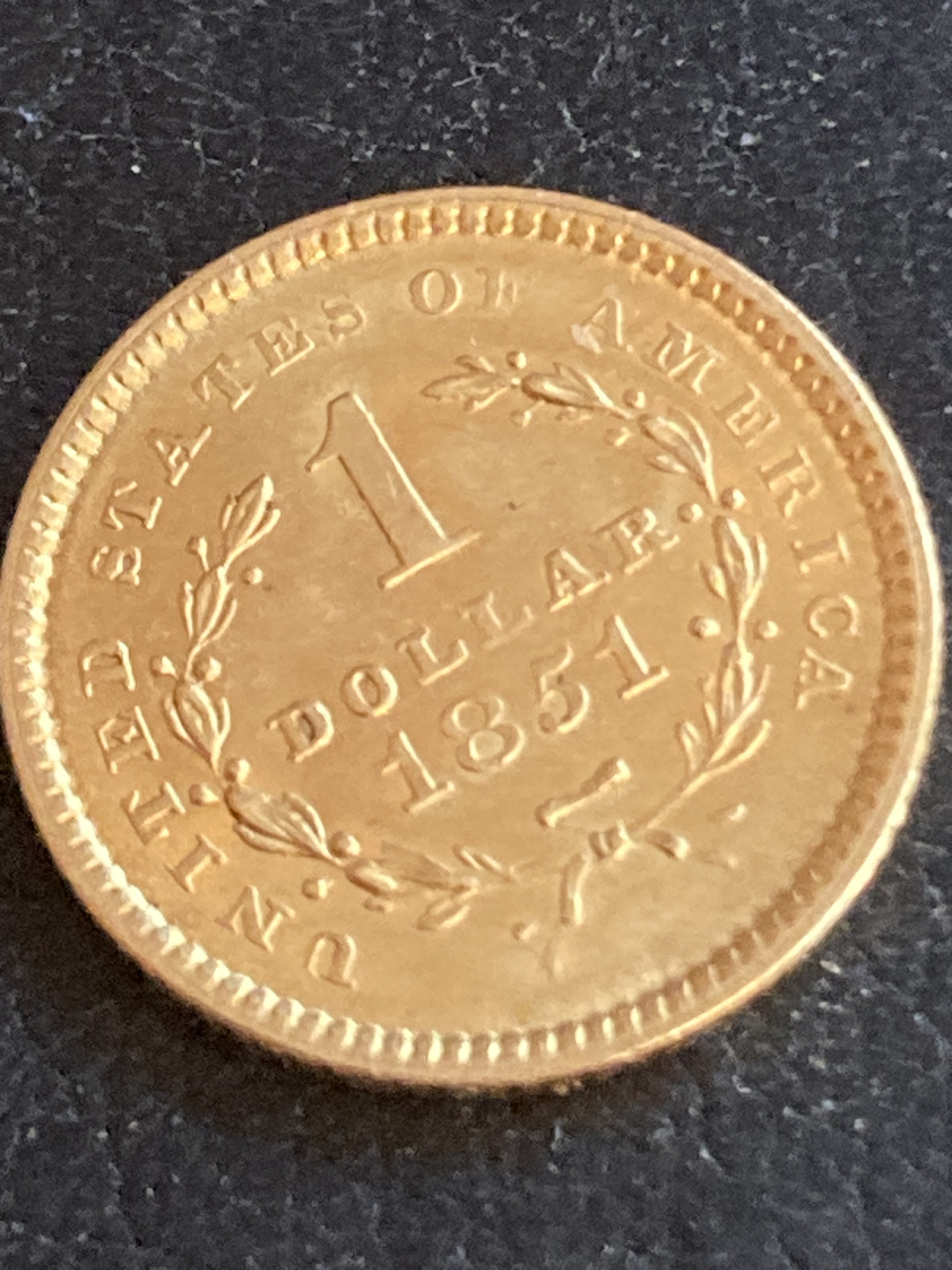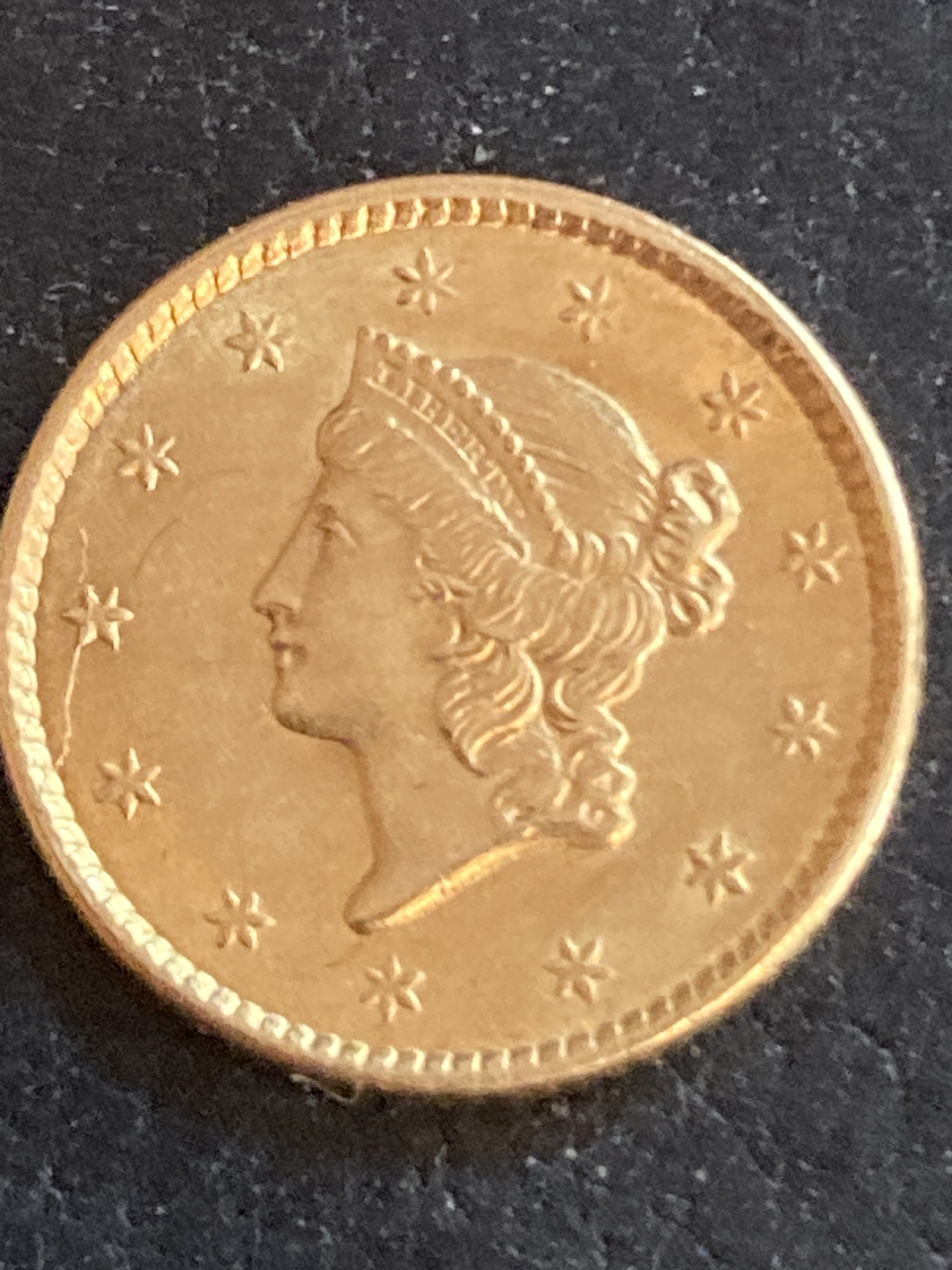Mint error 1851 $1- Liberty Gold
 Ppp
Posts: 563 ✭✭✭✭✭
Ppp
Posts: 563 ✭✭✭✭✭
To me this 1851 $1- Liberty gold dollar type I is a mint error (rotated reverse) and also has an obverse die crack at the 9 o’clock position.
Do you agree and if yes, then is it worth sending in for grading?


0
Comments
Are you talking about the obverse die crack, 8 o'clock to 10 ?
No premium for the die crack, so don’t send it in for that reason.
It looks to be about a 25° rotated reverse – to me, no premium,
but to others there might be a small premium.
worth grading as an AU55 for liquidity but not worth the money for the rotated Rev unless you want it designated for your collection.
11.5$ Southern Dollars, The little “Big Easy” set
A die crack is not an error.
Usually collectors like their rotations a minimum of 90 degrees
so I can’t see there being much of a premium there.
The only reason to send it in for grading is to guarantee authenticity.
A die crack is an error. Doesn't add much, if any, value. It is a die error.
I had an 1851 with more rotated reverse than that and it had no premium.
How many collectors really care about rotated reverses? How many of those who do are willing to pay a premium?
Hint to the original poster @Ppp: Those are not rhetorical questions. If you don't already have answers, you should get them first, before returning to the question at the top of this thread.
More than there used to be for what I have seen. Frankly on a 19th century coin, I don't care about rotated dies.
It might be the photo, but that coin looks "flat" with no luster. If so, it will get a "details" grade which makes the cost of grading a questionable investment.
This one is graded MS-64. And I just noted it has the same die crack. I don't know of the dies are rotated. I have never checked.
A die crack is a die state, resulting from a flaw. But i wouldn’t refer to either as an error.
Mark Feld* of Heritage Auctions*Unless otherwise noted, my posts here represent my personal opinions.
Thank you everyone for the replies.
I like error coins and have many graded examples however I do not have any gold. I too didn’t think the die crack would add any value but I was not sure about the rotated die. Again thank you for clearing that up.
I’d like to add that the obverses generally are not straight when you think they are on these. The star under the neck is actually the center, but most people line them up with it to the left. So the rotation is not as much as you’d think.
Gold coin errors are rare. The reason was that the mints were very careful not to let any out if they could help it. About 30 years ago Northeast Numismatics had an off-center $5 Liberty in high grade. The coin was really nice, but the price was $35,000, and at that time my life, I was lucky to come up with $5,000 for the business.
The same is true to a lesser extent for silver dollars. The bigger the coin is, the less chance there is to find an error.
looking at the prongs, it is rotated
I respectfully disagree. How about a CUD? Die state? Error?
Error.
Mark Feld* of Heritage Auctions*Unless otherwise noted, my posts here represent my personal opinions.
I don't know you personally, but from your posts on this board that I have read, I have the utmost respect for your knowledge. Not all of course, but a die crack can go from a small crack, to a larger crack, to a retained CUD, to a CUD. At what point does it go from die state to error? I understand that a die crack can be an indicator of a die state, but it can also be an error.
Thank you - I greatly appreciate that.
I’m having a hard time disagreeing with your logic and don’t have a firm answer to your question. How would you feel about a retained cud being the point at which an error is recognized?
Mark Feld* of Heritage Auctions*Unless otherwise noted, my posts here represent my personal opinions.
I'll have to think about it some. For decades I have considered a die crack an error, basically due to a weak spot in the die. I guess you can't teach an old dog new tricks. A split die is the ultimate die crack and, as far as I know, is universally considered an error.
A split die is the ultimate die crack and, as far as I know, is universally considered an error.
I’m just presenting my opinion, which isn’t necessarily correct. And I think part of this is just a matter of language and what meaning we give to various words. For example, is a “flaw” (which leads to a die-crack) an “error” in itself? If so, it should follow that a die crack, which results, would be an error.
So maybe in this case, there’s not a new trick to be taught to an old dog.😉
Mark Feld* of Heritage Auctions*Unless otherwise noted, my posts here represent my personal opinions.
I do not view die breaks and cuds as mint errors. They are markers of die states.
Errors include off-center strikes, coin struck out of collar, capped dies, off-medal strikes (wrong planchets), flip over double strikes and planchet clips.
Doubled dies and die making blunders are die varieties, not errors.
Historically, there were 3 categories of errors: Planchet errors such as clips, Die errors such as die cracks, and Striking errors such as off-center strikes. That conveniently lead to a P-D-S classification of error types. One of the books that promoted this system was Alan Herbert's The Official Price Guide To Mint Errors.
I see the logic for excluding die varieties as "not errors"... but that's not how the term has been used in the past.
No premium for the crack or the rotation, but worth submitting simply for the fact it's gold, if nothing else. It's a decent looking coin, and the crack and rotation are cool, even if they don't particularly add value.
Collector since 1976. On the CU forums here since 2001.
That is what I came up with from the error ref .com and variety vista web sources (but yours with the extra P D S classification). As I noted in the below link I think of the variety or die state versus error as two overlapping circles.
https://forums.collectors.com/discussion/1086168/variety-or-error-or#latest
https://youtube.com/watch?v=hYCRaWPlTIE Sophie Lloyd, guitar shred cover of Panama (Van Halen)
https://youtube.com/watch?v=dOV1VrDuUm4 Ted Nugent, Hibernation, Live 1976
RLJ 1958 - 2023